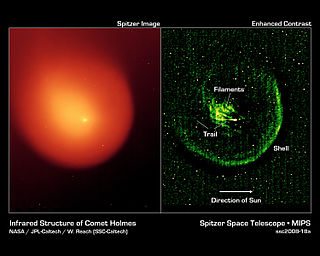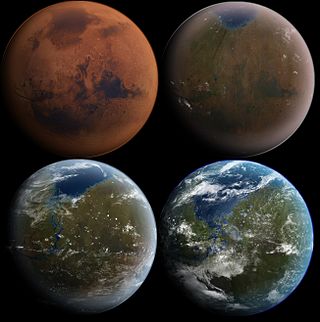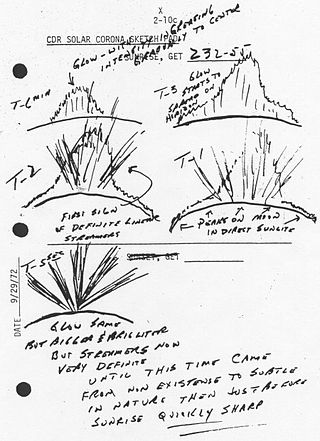Related Research Articles

The Mariner program was conducted by the American space agency NASA to explore other planets. Between 1962 and late 1973, NASA's Jet Propulsion Laboratory (JPL) designed and built 10 robotic interplanetary probes named Mariner to explore the inner Solar System - visiting the planets Venus, Mars and Mercury for the first time, and returning to Venus and Mars for additional close observations.

The solar wind is a stream of charged particles released from the upper atmosphere of the Sun, called the corona. This plasma mostly consists of electrons, protons and alpha particles with kinetic energy between 0.5 and 10 keV. The composition of the solar wind plasma also includes a mixture of materials found in the solar plasma: trace amounts of heavy ions and atomic nuclei of elements such as C, N, O, Ne, Mg, Si, S, and Fe. There are also rarer traces of some other nuclei and isotopes such as P, Ti, Cr, and 58Ni, 60Ni, and 62Ni. Superimposed with the solar-wind plasma is the interplanetary magnetic field. The solar wind varies in density, temperature and speed over time and over solar latitude and longitude. Its particles can escape the Sun's gravity because of their high energy resulting from the high temperature of the corona, which in turn is a result of the coronal magnetic field. The boundary separating the corona from the solar wind is called the Alfvén surface.

An aurora , also commonly known as the northern lights or southern lights, is a natural light display in Earth's sky, predominantly seen in high-latitude regions. Auroras display dynamic patterns of brilliant lights that appear as curtains, rays, spirals, or dynamic flickers covering the entire sky.

Mars Global Surveyor (MGS) was an American robotic space probe developed by NASA's Jet Propulsion Laboratory and launched November 1996. MGS was a global mapping mission that examined the entire planet, from the ionosphere down through the atmosphere to the surface. As part of the larger Mars Exploration Program, Mars Global Surveyor performed atmospheric monitoring for sister orbiters during aerobraking, and helped Mars rovers and lander missions by identifying potential landing sites and relaying surface telemetry.

Nozomi was a Japanese Mars orbiter that failed to reach Mars due to electrical failure. It was constructed by the Institute of Space and Astronautical Science, University of Tokyo and launched on July 4, 1998, at 03:12 JST with an on-orbit dry mass of 258 kg and 282 kg of propellant. The Nozomi mission was terminated on December 31, 2003.

Mars 96 was a failed Mars mission launched in 1996 to investigate Mars by the Russian Space Forces and not directly related to the Soviet Mars probe program of the same name. After failure of the second fourth-stage burn, the probe assembly re-entered the Earth's atmosphere, breaking up over a 320 km (200 mi) long portion of the Pacific Ocean, Chile, and Bolivia. The Mars 96 spacecraft was based on the Phobos probes launched to Mars in 1988. They were of a new design at the time and both ultimately failed. For the Mars 96 mission the designers believed they had corrected the flaws of the Phobos probes, but the value of their improvements was never demonstrated due to the destruction of the probe during the launch phase.

The coma is the nebulous envelope around the nucleus of a comet, formed when the comet passes near the Sun in its highly elliptical orbit. As the comet warms, parts of it sublimate; this gives a comet a diffuse appearance when viewed through telescopes and distinguishes it from stars. The word coma comes from the Greek κόμη (kómē), which means "hair" and is the origin of the word comet itself.

IMAGE is a NASA Medium Explorer mission that studied the global response of the Earth's magnetosphere to changes in the solar wind. It was believed lost but as of August 2018 might be recoverable. It was launched 25 March 2000, at 20:34:43.929 UTC, by a Delta II launch vehicle from Vandenberg Air Force Base on a two-year mission. Almost six years later, it unexpectedly ceased operations in December 2005 during its extended mission and was declared lost. The spacecraft was part of NASA's Sun-Earth Connections Program, and its data has been used in over 400 research articles published in peer-reviewed journals. It had special cameras that provided various breakthroughs in understanding the dynamics of plasma around the Earth. The principal investigator was Jim Burch of the Southwest Research Institute.

The Solar Dynamics Observatory (SDO) is a NASA mission which has been observing the Sun since 2010. Launched on 11 February 2010, the observatory is part of the Living With a Star (LWS) program.

The terraforming of Mars or the terraformation of Mars is a hypothetical procedure that would consist of a planetary engineering project or concurrent projects, with the goal to transform Mars from a planet hostile to terrestrial life to one that can sustainably host humans and other lifeforms free of protection or mediation. The process would involve the modification of the planet's extant climate, atmosphere, and surface through a variety of resource-intensive initiatives, and the installation of a novel ecological system or systems.
An extraterrestrial vortex is a vortex that occurs on planets and natural satellites other than Earth that have sufficient atmospheres. Most observed extraterrestrial vortices have been seen in large cyclones, or anticyclones. However, occasional dust storms have been known to produce vortices on Mars and Titan. Various spacecraft missions have recorded evidence of past and present extraterrestrial vortices. The largest extraterrestrial vortices are found on the gas giants, Jupiter and Saturn, and the ice giants, Uranus and Neptune.

The atmosphere of the Moon is a very scant presence of gases surrounding the Moon. For most practical purposes, the Moon is considered to be surrounded by vacuum. The elevated presence of atomic and molecular particles in its vicinity compared to interplanetary medium, referred to as "lunar atmosphere" for scientific objectives, is negligible in comparison with the gaseous envelopes surrounding Earth and most planets of the Solar System. The pressure of this small mass is around 3×10−15 atm (0.3 nPa), varying throughout the day, and in total mass less than 10 metric tonnes. Otherwise, the Moon is considered not to have an atmosphere because it cannot absorb measurable quantities of radiation, does not appear layered or self-circulating, and requires constant replenishment due to the high rate at which its gases are lost into space.

The climate of Mars has been a topic of scientific curiosity for centuries, in part because it is the only terrestrial planet whose surface can be easily directly observed in detail from the Earth with help from a telescope.

Mars is the fourth planet and the furthest terrestrial planet from the Sun. The reddish color of its surface is due to finely grained iron(III) oxide dust in the soil, giving it the nickname "the Red Planet". Mars's radius is second smallest among the planets in the Solar System at 3,389.5 km (2,106 mi). The Martian dichotomy is visible on the surface: on average, the terrain on Mars's northern hemisphere is flatter and lower than its southern hemisphere. Mars has a thin atmosphere made primarily of carbon dioxide, and two irregularly shaped natural satellites, Phobos and Deimos.

MAVEN is a NASA spacecraft orbiting Mars to study the loss of that planet's atmospheric gases to space, providing insight into the history of the planet's climate and water. The name is an acronym for "Mars Atmosphere and Volatile Evolution" while the word maven also denotes "a person who has special knowledge or experience; an expert". MAVEN was launched on an Atlas V rocket from Cape Canaveral Air Force Station, Florida, on 18 November 2013 UTC and went into orbit around Mars on 22 September 2014 UTC. The mission is the first by NASA to study the Mars atmosphere. The probe is analyzing the planet's upper atmosphere and ionosphere to examine how and at what rate the solar wind is stripping away volatile compounds.

The Parker Solar Probe is a NASA space probe launched in 2018 with the mission of making observations of the outer corona of the Sun. It will approach to within 9.86 solar radii from the center of the Sun, and by 2025 will travel, at closest approach, as fast as 690,000 km/h (430,000 mph) or 191 km/s, which is 0.064% the speed of light. It is the fastest object ever built.

Martian soil is the fine regolith found on the surface of Mars. Its properties can differ significantly from those of terrestrial soil, including its toxicity due to the presence of perchlorates. The term Martian soil typically refers to the finer fraction of regolith. So far, no samples have been returned to Earth, the goal of a Mars sample-return mission, but the soil has been studied remotely with the use of Mars rovers and Mars orbiters.

The Heliophysics Science Division of the Goddard Space Flight Center (NASA) conducts research on the Sun, its extended Solar System environment, and interactions of Earth, other planets, small bodies, and interstellar gas with the heliosphere. Division research also encompasses geospace—Earth's uppermost atmosphere, the ionosphere, and the magnetosphere—and the changing environmental conditions throughout the coupled heliosphere.

The Interstellar Mapping and Acceleration Probe(IMAP) is a heliophysics mission that will simultaneously investigate two important and coupled science topics in the heliosphere: the acceleration of energetic particles and interaction of the solar wind with the local interstellar medium. These science topics are coupled because particles accelerated in the inner heliosphere play crucial roles in the outer heliospheric interaction. In 2018, NASA selected a team led by David J. McComas of Princeton University to implement the mission, which is currently planned to launch in February 2025. IMAP will be a Sun-tracking spin-stabilized satellite in orbit about the Sun–Earth L1 Lagrange point with a science payload of ten instruments. IMAP will also continuously broadcast real-time in-situ data that can be used for space weather prediction.

Explorer 25, was a NASA magnetically aligned satellite launched simultaneously with Explorer 24 (AD-B) using a Scout X-4 launch vehicle. This was NASA's first dual-satellite launch. The satellite's primary mission was to make measurements of the influx of energetic particles into the atmosphere of Earth and to study atmospheric heating and the increase in scale height which have been correlated with geomagnetic activity. Studies of the natural and artificial trapped Van Allen radiation belts were also conducted. A biaxial fluxgate magnetometer was used to monitor the orientation of the spacecraft with respect to the local magnetic field.
References
- ↑ "In an ultraviolet glow, auroras on Mars spotted by UAE orbiter". NBC News. Retrieved 2021-12-07.
- ↑ "Auroras on Mars – NASA Science". science.nasa.gov. Retrieved 12 May 2015.
 This article incorporates text from this source, which is in the public domain .
This article incorporates text from this source, which is in the public domain . - ↑ Brown, Dwayne; Neal-Jones, Nancy; Steigerwald, Bill; Scott, Jim (18 March 2015). "NASA Spacecraft Detects Aurora and Mysterious Dust Cloud around Mars". NASA. Release 15-045. Retrieved 18 March 2015.
 This article incorporates text from this source, which is in the public domain .
This article incorporates text from this source, which is in the public domain . - ↑ Webster, Guy; Neal-Jones, Nancy; Scott, Jim; Schmid, Deb; Cantillo, Laurie; Brown, Dwayne (29 September 2017). "Large Solar Storm Sparks Global Aurora and Doubles Radiation Levels on the Martian Surface". NASA.
 This article incorporates text from this source, which is in the public domain .
This article incorporates text from this source, which is in the public domain . - ↑ Girazian, Z.; et al. (27 March 2022). "Space Physics: Discrete Aurora at Mars: Dependence on Upstream Solar Wind Conditions" (PDF). Journal of Geophysical Research . 127 (4). doi:10.1029/2021JA030238. PMID 35866072. S2CID 246029112.